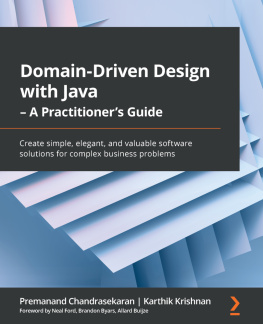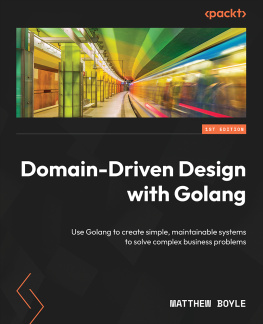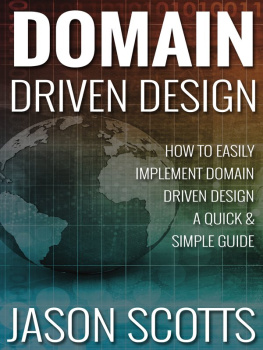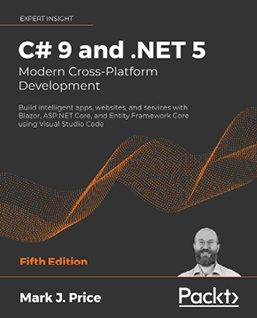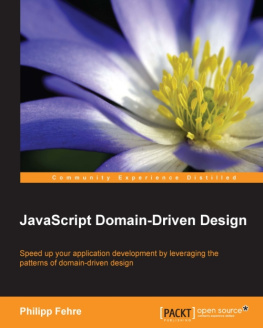Premanand Chandrasekaran - Domain-Driven Design with Java - A Practitioners Guide: Create simple, elegant, and valuable software solutions for complex business problems
Here you can read online Premanand Chandrasekaran - Domain-Driven Design with Java - A Practitioners Guide: Create simple, elegant, and valuable software solutions for complex business problems full text of the book (entire story) in english for free. Download pdf and epub, get meaning, cover and reviews about this ebook. year: 2022, publisher: Packt Publishing, genre: Home and family. Description of the work, (preface) as well as reviews are available. Best literature library LitArk.com created for fans of good reading and offers a wide selection of genres:
Romance novel
Science fiction
Adventure
Detective
Science
History
Home and family
Prose
Art
Politics
Computer
Non-fiction
Religion
Business
Children
Humor
Choose a favorite category and find really read worthwhile books. Enjoy immersion in the world of imagination, feel the emotions of the characters or learn something new for yourself, make an fascinating discovery.
- Book:Domain-Driven Design with Java - A Practitioners Guide: Create simple, elegant, and valuable software solutions for complex business problems
- Author:
- Publisher:Packt Publishing
- Genre:
- Year:2022
- Rating:4 / 5
- Favourites:Add to favourites
- Your mark:
Domain-Driven Design with Java - A Practitioners Guide: Create simple, elegant, and valuable software solutions for complex business problems: summary, description and annotation
We offer to read an annotation, description, summary or preface (depends on what the author of the book "Domain-Driven Design with Java - A Practitioners Guide: Create simple, elegant, and valuable software solutions for complex business problems" wrote himself). If you haven't found the necessary information about the book — write in the comments, we will try to find it.
Adopt a practical and modern approach to architecting and implementing DDD-inspired solutions to transform abstract business ideas into working software across the entire spectrum of the software development life cycle
Key Features- Implement DDD principles to build simple, effective, and well-factored solutions
- Use lightweight modeling techniques to arrive at a common collective understanding of the problem domain
- Decompose monolithic applications into loosely coupled, distributed components using modern design patterns
Domain-Driven Design (DDD) makes available a set of techniques and patterns that enable domain experts, architects, and developers to work together to decompose complex business problems into a set of well-factored, collaborating, and loosely coupled subsystems.
This practical guide will help you as a developer and architect to put your knowledge to work in order to create elegant software designs that are enjoyable to work with and easy to reason about. Youll begin with an introduction to the concepts of domain-driven design and discover various ways to apply them in real-world scenarios. Youll also appreciate how DDD is extremely relevant when creating cloud native solutions that employ modern techniques such as event-driven microservices and fine-grained architectures. As you advance through the chapters, youll get acquainted with core DDDs strategic design concepts such as the ubiquitous language, context maps, bounded contexts, and tactical design elements like aggregates and domain models and events. Youll understand how to apply modern, lightweight modeling techniques such as business value canvas, Wardley mapping, domain storytelling, and event storming, while also learning how to test-drive the system to create solutions that exhibit high degrees of internal quality.
By the end of this software design book, youll be able to architect, design, and implement robust, resilient, and performant distributed software solutions.
What you will learn- Discover how to develop a shared understanding of the problem domain
- Establish a clear demarcation between core and peripheral systems
- Identify how to evolve and decompose complex systems into well-factored components
- Apply elaboration techniques like domain storytelling and event storming
- Implement EDA, CQRS, event sourcing, and much more
- Design an ecosystem of cohesive, loosely coupled, and distributed microservices
- Test-drive the implementation of an event-driven system in Java
- Grasp how non-functional requirements influence bounded context decompositions
This book is for intermediate Java programmers looking to upgrade their software engineering skills and adopt a collaborative and structured approach to designing complex software systems. Specifically, the book will assist senior developers and hands-on architects to gain a deeper understanding of domain-driven design and implement it in their organization. Familiarity with DDD techniques is not a prerequisite; however, working knowledge of Java is expected.
Table of Contents- The Rationale for Domain-Driven Design
- The Mechanics of Domain-Driven Design
- Where and How Does DDD Fit?
- Domain Analysis and Modeling Using EventStorming
- Implementing Domain Logic
- Implementing the User Interface - Task-Based
- Implementing Queries
- Implementing Long-Running Flows
- Integrating with External Systems
- Beginning the decomposition journey
- Decomposing into finer-grained components
- Beyond Functional Requirements
Premanand Chandrasekaran: author's other books
Who wrote Domain-Driven Design with Java - A Practitioners Guide: Create simple, elegant, and valuable software solutions for complex business problems? Find out the surname, the name of the author of the book and a list of all author's works by series.

